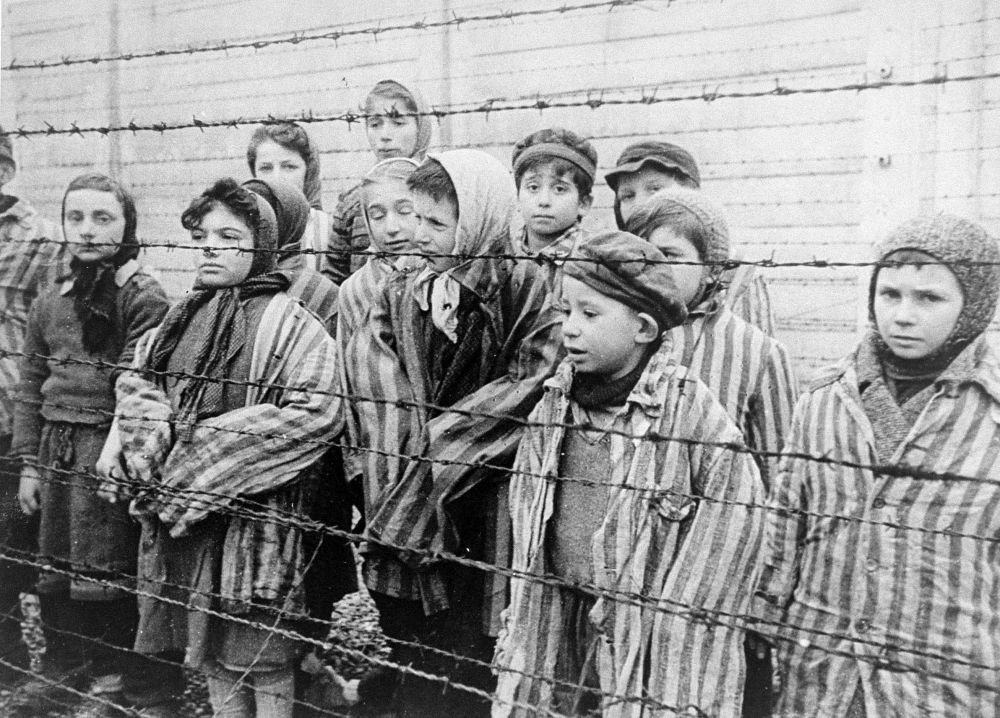- News
- Events
- Oneg Shabbat
- Collections
- Research
- Exhibitions
- Education
- Publishing Department
- Genealogy
- About the Institute
- Bookstore


Jewish children in the liberated Auschwitz camp. A still from a Soviet film by Aleksander Vorontsov, which was shot from January 28, 1945. United States Holocaust Memorial Museum
“And at some point in the distance we noticed the silhouettes of white-clad men who were walking towards the camp. We were not sure who these men were, and we even feared that it might be the Germans who wanted to eliminate us. (...) Immediately there were shouts of «zdravstvuytye tovarishchi» [hello comrades]. The Soviet soldiers told us not to be afraid, because «germantsov net» [Germans are gone]”, recalled a former Polish prisoner, Wanda Dramińska.
On January 27, 1945, the Auschwitz camp was liberated by the soldiers of the 100th and 322nd Rifle Divisions of the Soviet 60th Army. Horse scouts were the first to reach the German concentration and extermination camp. After short fights with the retreating German troops in the town of Oświęcim, during which 299 Soviet soldiers were killed, both camps – Auschwitz and Birkenau – were liberated around 3 PM.
At that time, there were approximately 7,000 prisoners in the liberated Auschwitz, Birkenau and Monowitz camps. They were mostly Jews, besides Poles, Belarusians and Russians – those who were unable to go west in the SS death marches. Poles who originated from nearby towns and had the strength to walk returned to their homes. Some fled because they were afraid of the return of the Germans. Inhabitants of Oświęcim and its vicinity crossed the barriers of the camp to see its interior with their own eyes and to help the prisoners. They took particular care of Jewish, Polish and Belarusian children, of whom there were over 500 in Auschwitz, including about 60 born in the camp. Some of the children were adopted by them, some found their original families.
Two Soviet field hospitals came to Auschwitz, and with the help of the Polish Red Cross, they took care of approx. 4,500 sick former prisoners, citizens of over 20 countries. These people suffered from tuberculosis, hunger diarrhea and other diseases, and were extremely starved. "The adults weighed an average of 30-35 kg," writes Andrzej Strzelecki. – "As late as May 1945, one female former prisoner, born in 1914, who was 160 cm tall, weighed 25 kg, and another who was 155 cm tall weighed 23 kg." From January 28, Soviet and Polish filmmakers shot a movie documenting German crimes in the liberated camp.
"It is impossible to describe in human words the meeting of the imprisoned, saved from certain death, with their liberators," recalled Regina Grimberg, a French Jew who belonged to the resistance movement in occupied France. – “Soviet officers and soldiers in rags, exhausted, freezing cold, but victorious, cried like little children at the sight of piles of corpses in front of barracks and people in agony, resembling skeletons, stacked on bunks. The female prisoners screamed, sobbed, and lovingly touched the clothes of their liberators to find out that these people were real, and kissed their hands."
“It may be sorry to say, but it is no big deal for a soldier during an offensive to see bodies of the dead, he had seen enough of them after all. But it was different here. These people did not die in the fight – it showed. A pile of emaciated bodies against the wall of the barracks. Snow has already covered them. And then a group of those who were shot. Men, women” – recalled the Soviet lieutenant Yuri Ilinsky. – “Children… children behind the wires. It left the strongest impression on me, on my soldiers. A whole crowd of children. From tiny two or three-year-olds to teenagers. Skinny, ragged, sick, hungry. We gave them everything that was in our backpacks."
“The children make a terrifying sight. Prematurely devastated organisms, aged, with sunken eyes. And yet these children screamed and played” – recalled Polish doctor Tadeusz Chowaniec.
______
Sources of quotations: Andrzej Strzelecki, Ostatnie drzwi obozu Auschwitz [The Last Days of the Auschwitz Camp], Oświęcim-Brzezinka State Museum, Oświęcim 1995.
______
![inter_holocaust_remembrance_day_2022.jpg [444.83 KB]](https://www.jhi.pl/storage/image/core_files/2022/1/26/091fe8b2df648705a0c67b76738fb0bc/jpg/jhi/preview/inter_holocaust_remembrance_day_2022.jpg)
The United Nations General Assembly designated January 27 – the anniversary of the liberation of Auschwitz-Birkenau – as International Holocaust Remembrance Day.
Learn more about the 2022 commemoration and education events (January-February)